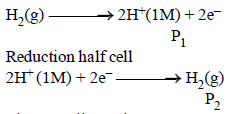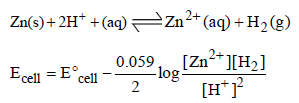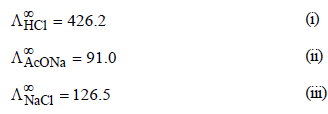Test: JEE Main 35 Year PYQs- Electrochemistry - JEE MCQ
30 Questions MCQ Test - Test: JEE Main 35 Year PYQs- Electrochemistry
Conductivity (unit Siemen’s S) is directly proportional toarea of the vessel and the concentration of the solution in itand is inversely proportional to the length of the vesselthen the unit of the constant of proportionality is [2002]
EMF of a cell in terms of reduction potential of its left andright electrodes is [2002]
What will be the emf for the given cell [2002]
Pt | H2 (P1) | H+ (aq) | | H2 (P2) | Pt
Pt | H2 (P1) | H+ (aq) | | H2 (P2) | Pt
Which of the following reaction is possible at anode?
When the sample of copper with zinc impurity is to be purified by electrolysis, the appropriate electrodes are
[2002]


Which of the following is a redox reaction? [2002]
For a cell reaction involving a two-electron change, thestandard e.m.f. of the cell is found to be 0.295 V at 25ºC. The equilibrium constant of the reaction at 25ºC will be [2003
Standard reduction electrode potentials of three metals A, B& C are respectively + 0.5 V, – 3.0 V & –1.2 V. The reducingpowers of these metals are [2003]
When during electrolysis of a solution of AgNO3 9650coulombs of charge pass through the electroplating bath,the mass of silver deposited on the cathode will be
For the redox reaction :
Zn(s) +Cu2+ (0.1M)→ Zn2+ (1M) + Cu(s) taking place in a cell,  is 1.10 volt. Ecell for the cell will be
is 1.10 volt. Ecell for the cell will be  [2003]
[2003]
Several blocks of magnesium are fixed to the bottom of a ship to [2003]
In a hydrogen-oxygen fuel cell, combustion of hydrogenoccurs to [2004]
Consider the following Eº values

Under standard conditions the potential for the reaction
 [2004]
[2004]
The standard e.m.f. of a cell involving one electron changeis found to be 0.591 V at 25ºC. The equilibrium constant ofthe reaction is (F = 96,500 C mol–1; R = 8.314 JK–1 mol–1) [2004]
The limiting molar conductivities Lº for NaCl, KBr and KClare 126, 152 and 150 S cm2 mol–1 respectively. The Lº forNaBr is [2004]
In a cell that utilises the reaction Zn(s) + 2H+ (aq) → Zn2++ H2(g) addition of H2SO4 to cathode compartment, will [2004]
The  values for Cr, Mn, Fe and Co are – 0.41, + 1.57, + 0.77 and + 1.97V respectively. For which one of these
values for Cr, Mn, Fe and Co are – 0.41, + 1.57, + 0.77 and + 1.97V respectively. For which one of these
metals the change in oxidation state from +2 to +3 is easiest? [2004]
For a spontaneous reaction the DG, equilibrium constant (K) and  will be respectively [2005]
will be respectively [2005]
The highest electrical conductivity of the following aqueoussolutions is of [2005]
Aluminium oxide may be electrolysed at 1000°C to furnishaluminium metal (At. Mass = 27 amu; 1 Faraday = 96,500Coulombs). The cathode reaction is– Al3+ + 3e- → Al° To prepare 5.12 kg of aluminium metal by this method werequire

Calculate  using appropriate molar conductances of the electrolytes listed above at infinite dilution in H2O
using appropriate molar conductances of the electrolytes listed above at infinite dilution in H2O
at 25°C
Which of the following chemical reactions depict the oxidizing beahviour of H2SO4?
The molar conductivities  and
and  at infinite dilution in water at 25ºC are 91.0 and 426.2 S cm2/mol
at infinite dilution in water at 25ºC are 91.0 and 426.2 S cm2/mol
respectively. To calculate  , the additional value required is
, the additional value required is
Resistance of a conductivity cell filled with a solution of an electrolyte of concentration 0.1 M is 100 W. The conductivity of this solution is 1.29 S m–1. Resistance of the same cell when filled with 0.2 M of the same solution is 520 W. The molar conductivity of 0.2 M solution of electrolyte will be [2006]
The equivalent conductances of two strong electrolytes at infinite dilution in H2O (where ions move freely through a
solution) at 25°C are given below : [2007]

What additional information/ quantity one needs to calculate  of an aqueous solution of acetic acid?
of an aqueous solution of acetic acid?
The cell, Zn | Zn2+ (1 M) || Cu2+ (1 M) | Cu  was allowed to be completely discharged at 298 K. The relative
was allowed to be completely discharged at 298 K. The relative
concentration of  is [2007]
is [2007]
Given  The potential for the cell Cr|Cr3+ (0.1M)|| Fe2+ (0.01 M)| Fe is [2008]
The potential for the cell Cr|Cr3+ (0.1M)|| Fe2+ (0.01 M)| Fe is [2008]
In a fuel cell methanol is used as fuel and oxygen gas is used as an oxidizer. The reaction is

At 298 K standard Gibb’s energies of formation for CH3OH(l), H2O(l) and and CO2 (g) are –166.2, –237.2 and –394.4 kJ
mol–1 respectively. If standard enthalpy of combustion of methonal is – 726 kJ mol–1, efficiency of the fuel cell will be:
[2009]
Given:

The value of standard electrode potential for the change, Fe3+ (aq) + e– →Fe2+ (aq) will be:
[2009]
The Gibbs energy for the decomposition of Al2O3 at 500°C is as follows :

The potential difference needed for electrolytic reductionof Al2O3 at 500°C is at least [2010]



























 reaction oxidation number of S is decreasing from + 6 to +4 hence undergoing reduction and for HI oxidation
reaction oxidation number of S is decreasing from + 6 to +4 hence undergoing reduction and for HI oxidation is given by the following equation
is given by the following equation
 is required.
is required.
































